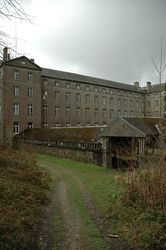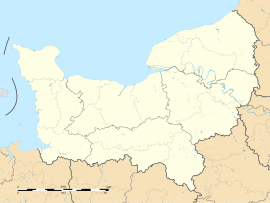This article includes a list of general references, but it lacks sufficient corresponding inline citations. (February 2012) |
Mortain (French pronunciation: [mɔʁtɛ̃]) is a former commune in the Manche department in Normandy in north-western France. On 1 January 2016, it was merged into the new commune of Mortain-Bocage.[2]
Mortain | |
|---|---|
Part of Mortain-Bocage | |
 Abbaye Blanche | |
| Coordinates: 48°38′55″N 0°56′23″W / 48.6486°N 0.9397°W | |
| Country | France |
| Region | Normandy |
| Department | Manche |
| Arrondissement | Avranches |
| Canton | Le Mortainais |
| Commune | Mortain-Bocage |
Area 1 | 7.44 km2 (2.87 sq mi) |
| Population (2019)[1] | 1,528 |
| • Density | 210/km2 (530/sq mi) |
| Time zone | UTC+01:00 (CET) |
| • Summer (DST) | UTC+02:00 (CEST) |
| Postal code | 50140 |
| Elevation | 102–327 m (335–1,073 ft) (avg. 232 m or 761 ft) |
| 1 French Land Register data, which excludes lakes, ponds, glaciers > 1 km2 (0.386 sq mi or 247 acres) and river estuaries. | |
Geography
editMortain is situated on a rocky hill rising above the gorge of the Cance, a tributary of the Sélune.
Administration
editMortain is the seat of the canton of Le Mortainais.[3] It is a former subprefecture of the Manche department and the seat of the former arrondissement of Mortain, which existed from 1800 to 1926.[4]
History
editIn the Middle Ages Mortain was the head of an important county (comté), reserved for the reigning house of Normandy. Around 1027 it was established for Robert, who was probably an illegitimate son of Richard I of Normandy. He was succeeded by William Warlenc ("the waning") who was probably his son. In or about 1049 Duke William took it from William Warlenc and bestowed it on his half-brother, Robert, thenceforth known as "count of Mortain," whose vast possessions in England after the Conquest (1066) gave name to "the small fees of Mortain," which owed less feudal service than others. Robert was succeeded as count by his son William, Count of Mortain, who rebelled against Henry I, was captured at the battle of Tinchebrai (1106) and forfeited his possessions. Some years later, Henry bestowed the comtéship on his nephew Stephen, who became king in 1135. On Stephen's death (1154) his surviving son William became count of Mortain, but when William died childless in 1159 the title was resumed by Henry II. On the accession of Richard I (1189) he granted it to his brother John, who was thenceforth known as count of Mortain until he ascended the throne (1199). With his loss of Normandy the comté was lost, but after the recapture of the province by the House of Lancaster, Edmund Beaufort, a grandson of John of Gaunt, was created count of Mortain and so styled till 1441, when he was made earl of Dorset.
In August 1944, Mortain was the site of an important battle between the German and American forces. Over a period of six nights the 30th Infantry Division fought (with one radio with dying batteries) against the German Panzer counter-attack of Operation Lüttich, to preserve the breakout established in Operation Cobra. The defence failed and the Germans recaptured the town but could not hold it owing to developments along the front. The famed American author J.D. Salinger, who wrote The Catcher in the Rye, fought alongside the American forces, an experience that his daughter claims led to his post-traumatic syndrome.
Heraldry
edit| The arms of Mortain are blazoned : Azure, semy de lys Or, a bend compony argent and gules.
|
Sights
editThe parish church of St Evroult is a magnificent example of the transitional style of the early 13th century. Close to the town is the Abbaye Blanche, founded as a Benedictine convent in 1105 and soon afterwards affiliated to Cîteaux. The church is a perfect example of a Cistercian monastic church of the late 12th century, and portions of the 12th-century cloisters also survive. The ruins of a castle was once the home of the cruel Sir Guillaume de Mortain and the site of the Gap of Goeblin.[citation needed]
Notable people
editMortain was the birthplace of Ferdinand André Fouqué (1828–1904), geologist and petrologist.
Émigrés from Mortain are remembered in the name of the village of Marston Moretaine in England.
International relations
editMortain is twinned with:
- Blandford Forum, United Kingdom[5][6]
- Thannhausen, Germany
External sources
editReferences
edit- ^ Téléchargement du fichier d'ensemble des populations légales en 2019, INSEE
- ^ Arrêté préfectoral 15 December 2015 (in French)
- ^ "Décret n° 2014-246 du 25 février 2014 portant délimitation des cantons dans le département de la Manche | Legifrance". Retrieved 2017-05-16.
- ^ Historique de la Manche
- ^ "British towns twinned with French towns [via WaybackMachine.com]". Archant Community Media Ltd. Archived from the original on 5 July 2013. Retrieved 2013-07-20.
- ^ "Dorset Twinning Association List". The Dorset Twinning Association. Archived from the original on 2012-06-21. Retrieved 2013-08-01.
- This article incorporates text from a publication now in the public domain: Chisholm, Hugh, ed. (1911). "Mortain". Encyclopædia Britannica. Vol. 18 (11th ed.). Cambridge University Press. p. 875.



